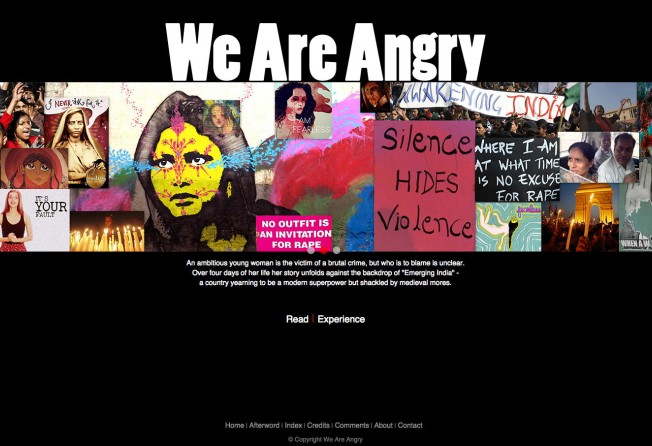'Digital story' takes reader to heart of rape victim's ordeal

As the words taunt, "You're not looking at the pictures of the car. Did you really look? You wanna see inside?", the reader is drawn to a slideshow of photos. The images show red stains on grubby white seat covers inside the car. This is the scene of a rape, and the graphic evidence is stomach-turning.
The reader knows it's fiction, that he or she is experiencing a "digital short story", but the experience feels journalistic, especially because it is set in New Delhi, where the real-life rape and eventual death of a student in December 2012 sent shockwaves around the world and sparked protests across India. Here, fiction feels uncomfortably close to fact.
Weareangry.net is a ground-breaking multimedia - or transmedia - work by Delhi-based American journalist and writer Lyndee Prickitt. Challenging both in its message and in its medium, it blends the written word with audio, video, pictures, statistics, thought bubbles, cartoons, artwork, music and more. At its bare bones it is a 6,000-word linear narrative written from the point of view of a rape victim - a voice rarely heard in patriarchal India.
The unravelling narrative is interspersed with different perspectives of a society grappling with the treatment of its women: the police who apathetically get the victim to hospital, the students-turned-protesters who are fed up with poor policing and governance, the surgeons who wonder why a woman is out so late at night, the parents who blame themselves for giving too much freedom to their girl-child, the wrongly accused who is brutalised, and the politicians who say little and do even less.
On the opening page of the website www.weareangry.net the reader is given two options: "read" or "experience". Clicking on the former allows you to read the self-contained text, but for those curious to see if multimedia storytelling works, the latter brings up page one of the story: photos from the crime scene, a rather startling audio montage of the word "rape" which plays automatically on PCs, a photo montage of paan (beetle nut) stains and animated text. The next page offers two "news articles" from fictional newspapers in India, which give more information about the crime as it unfolds in "real time".
The short video on page three is one of the most pivotal pieces of additional media in the story: you see two policemen prodding the unconscious victim and calling her a prostitute to the ire of two witnesses, one of whom is filming the incident, which goes viral and leads to protests. All of this is clear from the text alone, but the grainy video makes the story come alive.
But this isn't just an existing story with video, audio and pictures tacked on here and there. It's clear from the writing that it is a "born digital" piece, specially written for an electronic medium. It's on page one that the text taunts and teases the reader to engage with the multimedia elements. At another place, when a character refers to a satirical video about rape or an advert about women, there they are, the video boxes, playing for you.
Beyond that are hypertext words, beckoning you to click. For instance, click on the word paan and a definition opens up on the left - useful for those who have no idea what paan is; likewise for the Hindi swear words or local references (like a "dented and painted" woman). But the hypertext words go beyond definitions. Sometimes they are tangential thought bubbles (a fun device), sometimes a hypertext will take you to an apt quote made by a genuine scholar, sometimes it will open up a statistical graph or even a cartoon or interactive animation.
Being issue-based fiction that takes its cue from real-life events - which spawned heated debates, and a surge of editorial and artistic responses - there is a wealth of information packed into this story thanks to the digital format.
When the victim makes an oblique reference to the December 16, 2012, rape case on page four, the words "heard that one before" are hyperlinked to a small reference box that tells the reader about that case. This is a much more pleasing experience than the usual plethora of hyperlinks in an article that lazily just take you to another article. All background information is clearly summarised; there are source links for those who wish to delve deeper into the many issues surrounding India's rape crisis, making it nearly a compendium on the topic.
The idea of carefully curated reference material being available at a click, especially for subjects that are rooted in real social problems, is so obvious and helpful it's odd it hasn't been done before.
Transmedia is still be in its adolescent phase, but it may just be the future of storytelling.